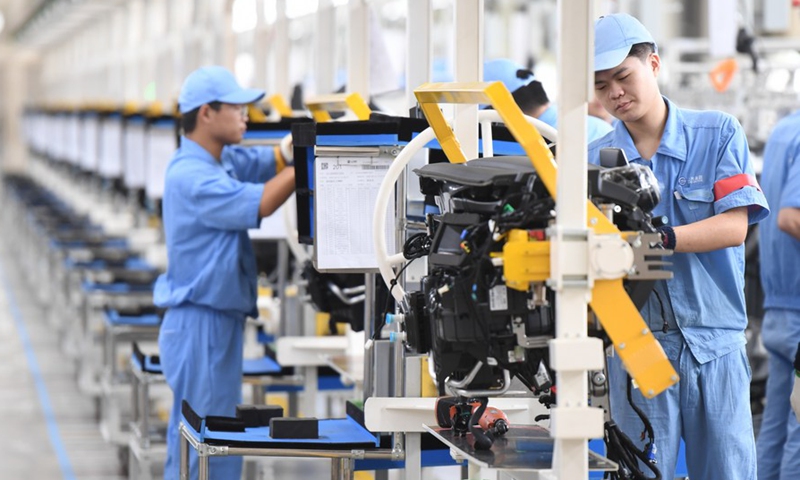
Workers assemble control system of instrument panel at a passenger car workshop of Ningde base of SAIC Motor Corporation Ltd. in Ningde, southeast China's Fujian Province, Sept. 15, 2020. (Xinhua/Song Weiwei)
Despite the impact of the COVID-19 pandemic and bilateral political tensions, economic complementarities between China and India have been underlined again by reports showing that Chinese automakers are stepping up efforts to develop in the Indian market, at a time when industrial players from the US and Europe have been stumbling out.
The Indian branch of SAIC Motor recently rolled out a new series named MG ASTOR in the Indian market. When pre-sales started on October 21, 5,000 vehicles were snapped up in just 20 minutes, with total orders exceeding 11,000 in the first two hours. The demand was so strong that the pre-sales later had to be paused, according to Chinese economic news outlet Yicai.
in contrast, auto giants from the US and Europe have been suffering setbacks in the Indian market, with some announcing their exit after recording huge losses. For instance, Ford Motor in September announced it would stop manufacturing in India after recording accumulated operating losses of more than $2 billion in 10 years in the country, according to India-based new outlet the Economic Times.
Italy-based Fiat and US-based General Motors among others have also quit the market.
The populous Indian market was once seen by global investors as one of the most promising markets for automobiles, like the Chinese market. But the two markets have seen diverging development.
The Western auto giants have made huge strides in the Chinese market, but suffered setbacks in India.
This is partly because most of the Western players in the industry focus on middle to high-end consumers across the world, with superior technologies and higher prices. It turned out that this did not fit the relatively slow-growing Indian market.
India’s GDP per capita in 2020 came to $1,900, compared to $10,500 in China. Industrial data showed that India only registered cars sales of about 3 million units in the year, with less than 27 cars owned per thousand people. Despite the massive population in India, the country’s consumption capacity remains relatively modest.
The country is also bedeviled by a lack of sufficient infrastructure, which is a tough problem for car producers, especially new energy vehicle firms. Electric car frontrunner Tesla is reportedly considering building factories in India, but it won’t be easy given the country’s poorly developed highway system, unstable power supply and shortage of related suppliers.
Unlike Western carmakers, Chinese auto firms can offer more suitable products with more reasonable prices for India’s middle and high-end markets. This is an example of the many complementarities in economic and trade exchanges between China and India.
However, this does not guarantee smooth cooperation. India has bureaucratic and inefficient governmental mechanisms, and New Delhi has shown a discriminatory attitude toward foreign capital as well as an ill-advised economic decoupling approach toward China, Chinese investors need to be fully prepared for these difficulties in the South Asian country.
It is hoped that the Indian government could resume a rational attitude and genuinely start to foster a fair and stable business environment for global investors. This would also be in line with the interests of Indian people.
The author is director of the Institute of Bay of Bengal Studies, Institute of China's Overseas Interests, Shenzhen University. bizopinion@globaltimes.com.cn
